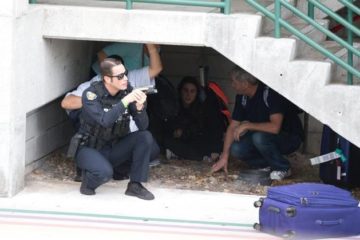A Better Way to Secure Our Airports: Marc Champion

(Bloomberg View) —The bombings in Brussels in March, like the crash of the EgyptAir flight in the Mediterranean this week, raised questions about the costs and benefits of adding more airport security, the topic of this column first published on March 24.
The departure hall bombing at Brussels airport has triggered debate over whether to move the security cordon at Europe’s airports to the terminal doors and beyond. Most travelers, I suspect, will have the same gut response: What, more lines?
That’s also the reaction of some aviation security experts, who believe that in the 15 years since 9/11, we have lost the balance between security, cost and convenience — often, they suspect, to little effect.
“I would really hope we do not introduce additional screening points in response to this,” said Philip Baum, editor of Aviation Security International Magazine and author of a book published this month, on the history of aviation hijacks and bombings. Not only are there more effective ways to provide security, says Baum, but “it’s taking away the pleasure of flight and travel.”
Security, it seems, has been an issue for as long as there have been commercial flights. The first hijacker — a Hungarian aristocrat, spy, paleontologist and would-be King of Albania by the name of Baron Franz von Nopcsa Felso-Szilvas — seized a plane at gunpoint in Budapest, in 1919. The first bomb to destroy a commercial airliner was a nitroglycerine-based device, stowed in the toilet of a United Airlines flight from Cleveland to Chicago, in 1933. (The perpetrator was never found — the lead investigator was reassigned to hunt Chicago gangsters Baby Face Nelson and Pretty Boy Floyd.)
Aviation regulators tend to respond to the most recent attack. Serious screening began in the U.S after 9/11, to prevent anyone again boarding a plane with a potential weapon like a box cutter. Carrying liquids on board was restricted after the U.K. uncovered a plot to down multiple-transatlantic aircraft using peroxide-based liquid explosives, in 2006. Body scanners were introduced after 2009, when an unsuccessful suicide bomber boarded a plane to Detroit with the components for a plastic explosive sewn into his underwear.
So now baggage and body screening at terminal entrances? Baum’s already concerned about the way increased security creates backed up lines after check-in. Screening people at the terminal entrance would just create a new set of lines and a new target, he told me. British Home Secretary Theresa May also dismissed the idea in parliament on Wednesday, saying that “you simply create the crowd in a different place.”
I’m not persuaded. I fly often into Istanbul in Turkey, where you get screened at the terminal entrance. It’s quick — no taking out laptops, because they are just looking for large weapons and bombs, such as the ones used this week at Zaventem. Lines are therefore short. Moscow’s Domodedovo airport does the same, following a 2011 suicide bombing in the arrivals hall. Indeed, terminal screening is common across the Middle East and Africa.
The point is to reduce risk, and the concentrations of people vulnerable to attack are dramatically larger in the departure and arrival halls, as people wait to check in or to greet loved-ones, than while they wait for the minute or so it takes to get through the terminal doors.
But there is a better reason to pause before adding another layer of baggage and body screens at the terminal doors: The Israelis don’t do it at Ben Gurion airport. They don’t bother restricting liquid containers either. Instead, they rely on profiling, questioning and behavioral monitoring by large numbers of highly trained plainclothes and uniformed staff. They watch and question. And Ben Gurion’s security is the gold standard.
Duplicating what Ben Gurion does would be much more expensive than adding a few scanners. And the aviation industry, which picks up much of the bill, already complains about the $8.5 billion annual cost. It would also be much more intrusive. If you have ever become a person of even mild interest to the staff at Ben Gurion, you’ll know what I mean. Nonetheless, the human intelligence approach has important advantages.
To start with, training people up and trusting their judgment is in itself a good. It creates genuine vigilance, rather than robotic box ticking. It also provides the tools to detect attackers who are about to use the next technique for wreaking aviation havoc, rather than the last, because it’s their behavior that counts. The training and experience can also be rolled out to apply to other large, soft targets, where airport-style security measures are simply not feasible. Profiling, of course, raises all kinds of red flags for civil liberties. Yet as Baum says, it is already widely used — including at airports, by customs officials and immigration officers. The quality of training would be critical.
As May said in her parliamentary statement, Europe has suffered 14 terrorist attacks since last January. The targets have included a magazine, a rock venue, a café, a grocery store, a soccer stadium, a train, a synagogue — and now an airport departures hall. So even if airport terminals can be hardened at reasonable cost, a different approach is needed. It needs to be as flexible as the terrorists are.
This column does not necessarily reflect the opinion of the editorial board or Bloomberg LP and its owners.






No Comment